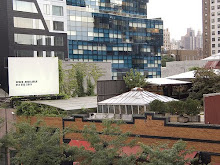

1) TBNYU protesters during the occupation, 2009 (NY Times). 2) Kimmel Today, 2009 (Politics as Puppetry blog).
60 Washington Square South between Thompson and LaGuardia Place
Second home to OSA club officers, a favorite of cafeteria cuisine aficionados, a safe haven for students to scam free food, and escape the stresses of school – the Kimmel Center for University Life, is a crucial destination on NYU’s campus. The sleek looking building , designed by Kevin Roche was built in 2003 to replace the dilapidated Loeb Student Center. At 10 pm on Wednesday, February 18th, 2009, around 70 students entered Kimmel and barricaded themselves inside its third floor cafeteria. They were led by student group, Take Back NYU (TBNYU) who declared their act the beginning of an occupation insisting on more transparent, ethical, and democratic practices by the university. After two years of unanswered letters by the administration, the group decided that this direct action was necessary. They would leave only when the administration recognized their eleven demands and agreed to negotiate. The group was able to hold the building until 2 pm on Friday, February 20th.
To expose this space’s role in the workings of race and power, we first look to give historical and local context to the space. The Kimmel Center stands ten stories tall on the south side of Washington Square Park - a site of historic struggles of power. From Jane Jacobs victory against Robert Moses’ plan to bulldoze through the park in the late 1950’s to the beatnik poets of the 1960’s, the park then was host to drug dealing and homeless shantytowns in the 1970’s and 80’s to intense racialized policing practices of Mayor Guiliani in the 1990’s. Undercover cops and surveillance systems today create what seems like a naturalized landscape while constantly regulating our social relations keeping those who are “threats” out. The logic is similar to the intense battle to maintain the property interest of whiteness in tact allowing only a few to experience and own its privileges.
Overlooking this space, the TBNYU occupation faced these forces. When students began to peacefully rally to support outside of Kimmel, police force arrived. The rallying students saw this public space culturally significant to their student community, home to all student led groups fighting social inequalities. Police forces did not respect that claim, similar to the climbers’ disrespect of the Lakota’s spiritual rock. The role of race in this struggle can be seen in the media’s fixation on the demands regarding the Gaza strip. One demand asked for thirteen scholarships for Palestinian students (thirteen to represent the 1300 people that had died in the most recent conflict) and another asked the university to “donate all exceeds supplies and materials in an effort to rebuild the University of Gaza”. These demands, although a symbolic act of solidarity with other student led occupations around the globe in defense of Palestine, were more importantly put on the list strategically, as bargaining chips, to achieve their larger goal of NYU disclosing their finances. In this case, color-blind rhetoric allowed media to criticize the students’ desires for foreigners without seeming racist as well as denying a focus on the real goals.
In the end, students were forcefully removed from the cafeteria. NYU students were first suspended but eventually allowed back into the school. None of their demands were met but TBNYU see their occupation as victory in the sense that they brought light to their struggle. When you ask students eating in Kimmel cafeteria today about its occupation last February, you will hear mixed responses - chuckles, tears, and even shrugs. Regardless of opinion, it was a crucial event in NYU’s history and its workings of race and power.
- Brittany Berryman and Sacha Morris
Sources
Berman, Marshall. "Introduction." New York Calling: From Blackout to Bloomberg. London: Reaktion Books, 2007. 1-9.
"Demands." Take Back NYU. 19 Oct. 2008. 3 Dec. 2009
Moynihan, Colin. "N.Y.U. Students Continue Occupation to Press Demands." New York Times [New York City] 19 Feb. 2009, NY ed
Schein, Richard. "Normative Dimensions of Landscape." Everyday America: Cultural Landscape Studies after J.B. Jackson. Berkeley: UC P, 2003. 199-218.

No comments:
Post a Comment